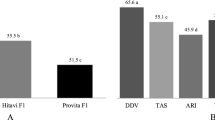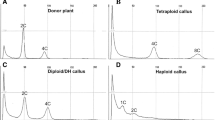Abstract
Anther culture is a convenient technique to obtain androgenic haploid and doubled haploid (DH) plants. In common eggplant (Solanum melongena), this technique has been used to develop DH pure lines for producing uniform F1 hybrid seed of some commercial varieties. However, a comprehensive study of the variation of this useful trait among different materials of common eggplant and related species is still lacking. In this work, we studied the androgenic response of 12 accessions of common eggplant and related materials from the primary (eggplant complex) and secondary genepools. We cultured anthers of all the accessions under the same experimental conditions, and studied their competence to produce calli, embryos and plants, as well as the quality and origin of the embryos produced. In our conditions, anthers of 11 out of the 12 accessions produced somatic calli, whereas only 5 also produced microspore-derived embryos, with variable results in terms of embryo quality and of frequency of embryo induction and plant germination. Embryos of responding accessions were initially haploid, and reached the DH status, verified with SSR markers, after a defined period of culture. In addition to other aspects common to many androgenesis-responsive species, our results allowed us to extract conclusions particular to common eggplant and relatives, including the difficulty for finding sources of androgenic competence out of S. melongena, the reduced impact of calli in the production of non-DH individuals, and the need to avoid the occurrence of severe anatomical and functional problems in the apex of most embryos, which seriously reduces their germinative success.




Similar content being viewed by others
References
Alpsoy HC, Seniz V (2007) Researches on the in vitro androgenesis and obtaining haploid plants in some eggplant genotypes. Acta Hortic 729:137–141
Barchi L, Lanteri S, Portis E, Stagel A, Vale G, Toppino L, Rotino GL (2010) Segregation distortion and linkage analysis in eggplant (Solanum melongena L.). Genome 53:805–815
Behera TK, Singh N (2002) Inter-specific crosses between eggplant (Solanum melongena L.) with related Solanum species. Sci Hortic 95:165–172
Bletsos F, Roupakias D, Tsaktsira M, Scaltsoyjannes A (2004) Production and characterization of interspecific hybrids between three eggplant (Solanum melongena L.) cultivars and Solanum macrocarpon L. Sci Hortic 101:11–21
Borgel A, Arnaud M (1986) Progress in eggplant breeding, use of haplomethod. Capsicum Newsl 5:65–66
Chakravarthi DVN, Rao YV, Rao MVS, Manga V (2010) Genetic analysis of in vitro callus and production of multiple shoots in eggplant. Plant Cell Tiss Org Cult 102:87–97
Corral-Martínez P, Seguí-Simarro JM (2010) Improvement in doubled haploid production through in vitro culture of isolated eggplant microspores. In: Prohens J, Rodríguez-Burruezo A (eds) Advances in genetics and breeding of Capsicum and eggplant. UPV Press, Valencia, pp 369–374
Corral-Martínez P, Nuez F, Seguí-Simarro JM (2011) Genetic, quantitative and microscopic evidence for fusion of haploid nuclei and growth of somatic calli in cultured ms10 35 tomato anthers. Euphytica 178:215–228
Daunay MC (2008) Eggplant. In: Prohens J, Nuez F (eds) Handbook of plant breeding: vegetables II. Springer, New York, pp 163–220
Dumas de Vaulx R, Chambonnet D (1982) Culture in vitro d’anthères d’aubergine (Solanum melongena L.): stimulation de la production de plantes au moyen de traitements à 35°C associés à de faibles teneurs en substances de croissance. Agronomie 2:983–988
Dunwell JM (2010) Haploids in flowering plants: origins and exploitation. Plant Biotechnol J 8:377–424
FAOSTAT (2010) http://faostat.fao.org. Accessed 9 Mar 2011
Ferrie A (2003) Microspore culture of Brassica species. In: Maluszynski M, Kasha KJ, Forster BP, Szarejko I (eds) Doubled haploid production in crop plants: a manual. Kluwer, Dordrecht, pp 205–215
Ferriol M, Pico B, Nuez F (2003) Genetic diversity of a germplasm collection of Cucurbita pepo using SRAP and AFLP markers. Theor Appl Genet 107:271–282
Furini A, Wunder J (2004) Analysis of eggplant (Solanum melongena)-related germplasm: morphological and AFLP data contribute to phylogenetic interpretations and germplasm utilization. Theor Appl Genet 108:197–208
Gémes Juhasz A, Venczel G, Sagi ZS, Gajdos L, Kristof Z, Vagi P, Zatyko L (2006) Production of doubled haploid breeding lines in case of paprika, spice paprika, eggplant, cucumber, zucchini and onion. Acta Hortic 725:845–854
Germanà M (2011) Gametic embryogenesis and haploid technology as valuable support to plant breeding. Plant Cell Rep 30:839–857
Gisbert C, Prohens J, Nuez F (2006) Efficient regeneration in two potential new crops for subtropical climates, the scarlet (Solanum aethiopicum) and gboma (S. macrocarpon) eggplants. N Z J Crop Hortic Sci 34:55–62
Isouard G, Raquin C, Demarly Y (1979) Obtention de plantes haploides et diploides par culture in vitro d’anthères dáubergine (Solanum melongena L.). C R Acad Sci Paris 288:987–989
Lester RN, Hasan SMZ (1991) Origin and domestication of the brinjal-eggplant, Solanum melongena, from S. incanum in Africa and Asia. In: Hawkes JH, Lester RN, Nee M, Estrada N (eds) Solanaceae III: taxonomy chemistry evolution. The Royal Botanic Gardens Kew, Richmond, pp 369–387
Malik MR, Wang F, Dirpaul J, Zhou N, Hammerlindl J, Keller W, Abrams SR, Ferrie AMR, Krochko JE (2008) Isolation of an embryogenic line from non-embryogenic Brassica napus cv. Westar through microspore embryogenesis. J Exp Bot 59:2857–2873
Manzur JP (2009) Obtención y caracterización de marcadores microsatélite (SSRs) de berenjena (Solanum melongena) a partir de una genoteca enriquecida. MSc Thesis. Universidad Politécnica de Valencia, Valencia
Matsubara S, Hu KL, Murakami K (1992) Embryoid and callus formation from pollen grains of eggplant and pepper by anther culture. J Jpn Soc Hortic Sci 61:69–77
Mennella G, Rotino GL, Fibiani M, D’Alessandro A, Francese G, Toppino L, Cavallanti F, Acciarri N, Lo Scalzo R (2010) Characterization of health-related compounds in eggplant (Solanum melongena L.) lines derived from introgression of allied species. J Agric Food Chem 58:7597–7603
Miller JC, Tanksley SD (1990) RFLP analysis of phylogenetic relationships and genetic variation in the genus Lycopersicon. Theor Appl Genet 80:437–448
Miyoshi K (1996) Callus induction and plantlet formation through culture of isolated microspores of eggplant (Solanum melongena L). Plant Cell Rep 15:391–395
Muñoz-Falcón JE, Prohens J, Vilanova S, Nuez F (2008a) Characterization, diversity, and relationships of the Spanish striped (Listada) eggplants: a model for the enhancement and protection of local heirlooms. Euphytica 164:405–419
Muñoz-Falcón JE, Prohens J, Vilanova S, Ribas F, Castro A, Nuez F (2008b) Distinguishing a protected geographical indication vegetable (Almagro eggplant) from closely related materials with selected morphological traits and molecular markers. J Sci Food Agric 89:320–328
Muñoz-Falcón JE, Prohens J, Vilanova S, Nuez F (2009) Diversity in commercial varieties and landraces of black eggplants and implications for broadening the breeders gene pool. Ann Appl Biol 154:453–465
Nikova V, Philipov P, Zayova E, Krusteva L (2007) Biotechnological methods in eggplant (Solanum melongena L.) improvement. Genet Breed 36:39–55
Nunome T, Suwabe K, Iketani H, Hirai M (2003) Identification and characterization of microsatellites in eggplant. Plant Breed 122:256–262
Prohens J, Rodríguez-Burruezo A, Raigón MD, Nuez F (2007) Total phenolics concentration and browning susceptibility in a collection of different varietal types and hybrids of eggplant: implications for breeding for higher nutritional quality and reduced browning. J Am Soc Hortic Sci 132:638–646
Raina SK, Iyer RD (1973) Differentiation of diploid plants from pollen callus in anther cultures of Solanum melongena L. Z Pflanzenzucht 70:275–280
Rizza F, Mennella G, Collonnier C, Shiachakr D, Kashyap V, Rajam MV, Prestera M, Rotino GL (2002) Androgenic dihaploids from somatic hybrids between Solanum melongena and S. aethiopicum group Gilo as a source of resistance to Fusarium oxysporum f. sp. melongenae. Plant Cell Rep 20:1022–1032
Rotino GL (1996) Haploidy in eggplant. In: Jain SM, Sopory SK, Veilleux RE (eds) In vitro haploid production in higher plants. Kluwer, Dordrecht, pp 115–141
Rotino GL, Falavigna A, Restaino F (1987) Production of anther-derived plantlets of eggplant. Capsicum Newsl 6:89–90
Rotino GL, Restaino F, Gjomarkaj M, Massimo M, Falavigna A, Schiavi M, Vicini E (1991) Evaluation of genetic variability in embryogenetic and androgenetic lines of eggplant. Acta Hortic 300:357–362
Rotino GL, Sihachakr D, Rizza F, Vale G, Tacconi MG, Alberti P, Mennella G, Sabatini E, Toppino L, D’Alessandro A, Acciarri N (2005) Current status in production and utilization of dihaploids from somatic hybrids between eggplant (Solanum melongena L.) and its wild relatives. Acta Physiol Plant 27:723–733
Sanchez-Mata MC, Yokoyama WE, Hong YJ, Prohens J (2010) α-solasonine and α-solamargine contents of gboma (Solanum macrocarpon L.) and scarlet (Solanum aethiopicum L.) eggplants. J Agric Food Chem 58:5502–5508
Sanguineti MC, Tuberosa R, Conti S (1990) Field evaluation of androgenetic lines of eggplant. Acta Hortic 280:177–182
Seguí-Simarro JM (2010) Androgenesis revisited. Bot Rev 76:377–404
Seguí-Simarro JM, Nuez F (2005) Meiotic metaphase I to telophase II is the most responsive stage of microspore development for induction of androgenesis in tomato (Solanum lycopersicum). Acta Physiol Plant 27:675–685
Seguí-Simarro JM, Nuez F (2008) Pathways to doubled haploidy: chromosome doubling during androgenesis. Cytogenet Genome Res 120:358–369
Seguí-Simarro JM, Corral-Martínez P, Parra-Vega V, González-García B (2011) Androgenesis in recalcitrant solanaceous crops. Plant Cell Rep 30:765–778
Stagel A, Portis E, Toppino L, Rotino GL, Lanteri S (2008) Gene-based microsatellite development for mapping and phylogeny studies in eggplant. BMC Genomics 9:357
Stommel JR, Whitaker BD (2003) Phenolic acid content and composition of eggplant fruit in a germplasm core subset. J Am Soc Hortic Sci 128:704–710
Tuberosa R, Sanghineti MC, Conti S (1987) Anther culture of eggplant Solanum melongena L. lines and hybrids. Genética Agrária 41:267–274
Wedzony M, Forster BP, Zur I, Golemiec E, Szechynska-Hebda M, Dubas E, Gotebiowska G (2009) Progress in doubled haploid technology in higher plants. In: Touraev A, Forster BP, Jain SM (eds) Advances in haploid production in higher plants. Springer, Dordrecht, pp 1–33
Acknowledgments
We acknowledge Drs. Begoña Renau and Antonio Serrano, and Mrs Nuria Palacios for their excellent technical work, as well as the staff of the COMAV greenhouses for their valuable help. Thanks are also due to Dr. Santiago Vilanova for providing us with the SSRs used in this work. This work was supported by grants from Spanish MICINN AGL2006-06678 and AGL2010-17895 to JMSS, and AGL2009-07257 to JP.
Author information
Authors and Affiliations
Corresponding author
Rights and permissions
About this article
Cite this article
Salas, P., Prohens, J. & Seguí-Simarro, J.M. Evaluation of androgenic competence through anther culture in common eggplant and related species. Euphytica 182, 261–274 (2011). https://doi.org/10.1007/s10681-011-0490-2
Received:
Accepted:
Published:
Issue Date:
DOI: https://doi.org/10.1007/s10681-011-0490-2




